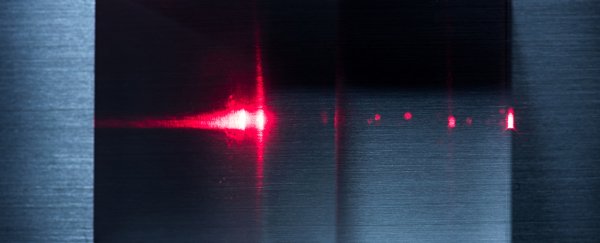At just 53 attoseconds, a single flash of an X-ray laser has become the shortest light pulse of its kind in the history of optics, smashing the previous record by 14 attoseconds.
As cool as it is, the record light pulse is more than just about bragging rights. The advance will improve research that requires measuring the positions and behaviours of particles within atoms and molecules in ways that could open doors to new kinds of technology.
The boundaries on ultrafast light pulses have been steadily narrowing since lasers were first developed in the 1960s.
We've come a long way since those first millisecond pulses, with the duration now measured in just a few dozen quintillionths of a second.
Researchers from the University of Central Florida had also set the previous record of 67 attoseconds back in 2012, only that time they'd used pulses of UV light.
In this latest experiment they've shortened the wavelength as well as the pulse, achieving the tiny blip of light with light in the more energetic X-ray part of the spectrum.
For some perspective on how quick this is, in a single second light can travel around the Earth 7.5 times. In 53 attoseconds, imagine light travelling only the distance of about a thousandth of the width of a human hair.
Breaking light down into such short pulses has some serious physical applications.
"Such attosecond soft X-rays could be used to shoot slow-motion video of electrons and atoms of biological molecules in living cells to, for instance, improve the efficiency of solar panels by better understanding how photosynthesis works," says researcher Zenghu Chang.
On an atomic scale, certain measurements are made easier by relating them to common units.
The atomic unit for time is a ridiculously tiny 24 attoseconds, so having pulses that come close to that help improve resolution just as a faster camera allows us to record high-speed events like popping balloons or speeding bullets.
Previous records were accomplished using processes that limited the energy in the pulse to around 100 electron volts.
So the researchers tweaked the process to raise the amount of energy within the light pulse while still making the overall burst quite short.
Ultrashort pulses among the more energetic X-ray part of the spectrum, above 124 electron volts, have a distinct advantage.
Electrons can only leap from their orbitals around the nucleus once they absorb specific quanta – or units – of light energy.
One way physicists describe the specific energy holding electrons in place comes from experiments done using X-rays.
This X-ray notation labels the orbitals with letters and numbers, with K1 as the first, then L1, L2, L3, M1, and so forth.
Hitting the K-edge for carbon is a milestone that allows researchers to target the electrons nearest the carbon atom's nucleus and watch the pinball-effects of electrons bouncing about.
"The photon energy of the attosecond X-ray pulses is two times higher than previous attosecond light sources and reached the carbon K-edge (284 eV), which makes it possible to probe and control core electron dynamics such as Auger processes," says Chang.
Light at K-edge energies also allows researchers to send pulses through what's known as the water window – the part of the spectrum where water is transparent to soft X-rays.
"This sets the stage for many new kinds of experiments, and pushes physics forward with the ability to understand matter better than ever before," says Rich Hammond from the US Army Research Office, who were responsible for funding the research.
Advancing technology means even the finest atomic processes need to be taken into account; understanding how electrons behave in a relatively complex atom like carbon potentially opens the way to squeezing more out of electronics and revealing the quantum underpinnings of biology.
This research was published in Nature Communications.
